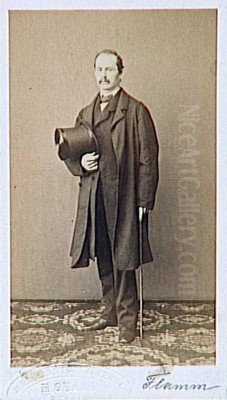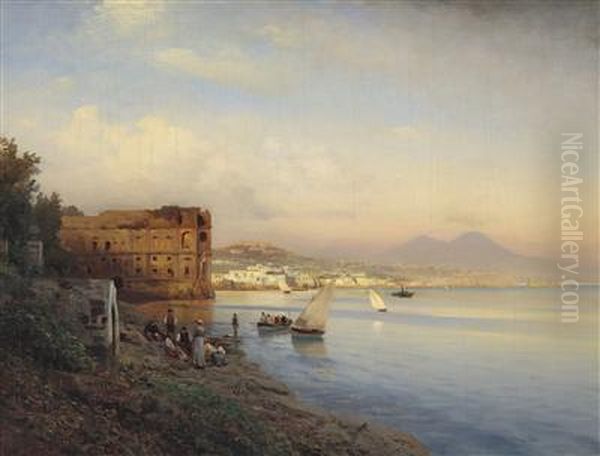
Albert Flamm (1823-1906) stands as a significant figure within the German art landscape of the 19th century, particularly renowned for his evocative depictions of Italy. A prominent member of the later Düsseldorf School of Painting, Flamm dedicated much of his career to capturing the sun-drenched vistas, coastal scenes, and picturesque life of the Italian peninsula, earning considerable acclaim both domestically and internationally. His work embodies the detailed realism blended with romantic sensibility characteristic of his milieu, yet possesses a distinct focus on the atmospheric effects of light and color found under southern skies.
Early Life and Artistic Formation in Düsseldorf
Born in Cologne in 1823, Albert Flamm's artistic journey began not with painting, but with architecture. He initially enrolled at the prestigious Kunstakademie Düsseldorf (Düsseldorf Art Academy) to study architectural design. However, the allure of the brush proved stronger, and in 1841, he made the pivotal decision to switch his focus to painting. This move placed him under the tutelage of one of the academy's leading lights, the landscape painter Andreas Achenbach.
The Düsseldorf Academy in the mid-19th century was a powerhouse of artistic education in Europe, attracting students from across Germany, Scandinavia, Russia, and even the United States. It was known for its rigorous training, emphasizing detailed observation, technical proficiency, and often, landscape painting. Figures like Johann Wilhelm Schirmer and Carl Friedrich Lessing had established a strong landscape tradition, and Andreas Achenbach was a dominant force, known for his dramatic northern seascapes and meticulous realism. Studying under Andreas provided Flamm with a solid technical foundation.
The Influence of the Achenbachs and the Düsseldorf Milieu
Flamm's connection to the Achenbach family extended beyond the student-teacher relationship. He developed a close and lasting friendship with Andreas's younger brother, Oswald Achenbach, who would also become a highly celebrated landscape painter, specializing, like Flamm, primarily in Italian scenes. This friendship proved artistically stimulating for both painters, involving shared travels and mutual support throughout their careers.

The artistic environment of Düsseldorf was vibrant. Flamm became integrated into the city's artistic social fabric, notably joining the influential artists' association "Malkasten" (Paintbox) in 1849. This association served as a crucial hub for social interaction, intellectual exchange, and professional networking among Düsseldorf's creative community, which included painters, writers, and musicians. Flamm remained based in Düsseldorf for the majority of his life, establishing it as his home and professional center until his death in 1906.
His personal life also became intertwined with his artistic circle. Flamm married Anna Arnz, whose sister Julie was married to his close friend, Oswald Achenbach. This familial connection further solidified his ties within the Düsseldorf art scene and likely facilitated continued collaboration and shared experiences, particularly concerning their mutual artistic passion for Italy.
The Lure of Italy: Travels and Inspirations
Like many Northern European artists of his time, Flamm felt the powerful draw of Italy. The peninsula represented not only the cradle of classical antiquity and the Renaissance but also offered landscapes bathed in a quality of light and color vastly different from that of Germany. The tradition of the Grand Tour had cemented Italy as an essential destination for artistic pilgrimage, providing subjects ranging from ancient ruins and Renaissance architecture to stunning coastlines and vibrant folk life.
Flamm undertook several journeys to Italy, which became the primary source of inspiration for his oeuvre. A particularly significant trip occurred in the summer of 1850, when he traveled extensively with Oswald Achenbach. Starting from Rome, they explored the surrounding countryside, known as the Roman Campagna, venturing into areas that had inspired landscape painters for centuries. During this journey, they encountered other notable artists, including the Swiss symbolist Arnold Böcklin, Ludwig Thiersch, and the German painter Heinrich Dreber, fostering a rich exchange of ideas and artistic perspectives amidst the inspiring Italian setting.
These travels provided Flamm with a wealth of sketches, studies, and memories that would fuel his studio production for years to come. He became particularly adept at capturing the landscapes of Rome and its environs, the Bay of Naples (including Capri and Sorrento), the Amalfi Coast, and Sicily. His depictions often went beyond mere topography, incorporating elements of local life and folklore, adding a genre dimension to his landscapes.
Artistic Style: Light, Color, and the Italian Scene
Albert Flamm's artistic style is firmly rooted in the Düsseldorf School's tradition of detailed observation and technical finish, yet it is distinguished by his particular sensitivity to the effects of Mediterranean light and atmosphere. His works are celebrated for their clarity, luminous color palettes, and often idyllic or romanticized portrayal of Italian scenery.
Early in his career, Flamm's style adhered more closely to the meticulous detail favored by his teacher, Andreas Achenbach. However, influenced perhaps by his travels, his friendship with Oswald Achenbach (whose style became known for its atmospheric vibrancy and looser brushwork), and evolving artistic tastes, Flamm's later works often exhibit a broader handling of paint and a greater emphasis on overall atmospheric effect rather than minute detail. His brushwork became more visible, and his application of color grew richer and sometimes heavier, effectively conveying the warmth and intensity of the southern sun.
He showed a particular fondness for depicting coastal scenes under bright sunlight or during the golden hours of late afternoon and twilight. The interplay of light on water, rocks, and architecture became a hallmark of his work. He masterfully rendered the azure blues of the Mediterranean Sea, the warm ochres and terracottas of Italian buildings, and the lush greens of southern vegetation, all unified by a convincing sense of natural light. While grounded in realism, his landscapes often possess a serene, picturesque quality, sometimes bordering on the idealized, which appealed greatly to the tastes of his contemporary audience.
Representative Works
Several paintings stand out as representative of Albert Flamm's focus and style:
View of the Amalfi Coast (or Amalfi Coast Landscape): This subject, which he painted multiple variations of, perfectly encapsulates his strengths. These works typically feature the dramatic cliffs and sparkling waters of the Amalfi Coast, often bathed in warm sunlight. The detailed rendering of the rocky coastline contrasts with the softer treatment of the sea and sky, showcasing his ability to balance precision with atmospheric effect. The vibrant blues and warm earth tones are characteristic.
Coastal Landscape near Capri: Capri, with its famous rock formations (Faraglioni) and grottoes, was another favorite location. Flamm's depictions of Capri often emphasize the brilliant Mediterranean light reflecting off the water and the rugged beauty of the island's coastline. Figures of fishermen or local inhabitants might be included to add scale and narrative interest.
Procession in the Roman Campagna: This work highlights Flamm's interest in incorporating genre elements. The vast, rolling landscape of the Campagna, often dotted with ancient ruins or distant views of the Alban Hills, serves as a backdrop for scenes of local life, such as religious processions or peasants traveling along dusty roads. These paintings combine landscape grandeur with ethnographic detail.
Landscape in the Roman Campagna: Similar to the above, but perhaps focusing more purely on the landscape itself, these works capture the unique character of the countryside surrounding Rome – its wide-open spaces, ancient aqueducts, umbrella pines, and the distinctive quality of light, often rendered during the hazy heat of summer or the clear light of spring.
These works, and others like them, solidified Flamm's reputation as a leading painter of Italian views. They were sought after by collectors in Germany and abroad, finding their way into numerous private and public collections.
Relationships, Influence, and Contemporaries
Albert Flamm's career unfolded within a rich network of artistic relationships. His bond with Oswald Achenbach was arguably the most significant, marked by shared artistic interests, travels, and familial ties. While both specialized in Italy, Oswald's style often leaned towards more dramatic atmospheric effects and a freer application of paint, whereas Flamm often retained a greater degree of clarity and detail, though his later work showed convergence.
Flamm also played a role in transmitting the Düsseldorf style and his approach to landscape to other artists. The American painter William Keith, who later became famous for his depictions of the Californian landscape, studied briefly with Flamm in Düsseldorf around 1869-1870. Keith acknowledged the influence of his European training, including his time with Flamm, on his subsequent development, particularly in terms of composition and the handling of light, although his later style evolved significantly towards a more Tonalist or Barbizon-influenced aesthetic.
Another notable student or associate was the Norwegian painter Adelsteen Normann, known for his dramatic fjord landscapes. Normann studied at the Düsseldorf Academy in the late 1860s and early 1870s, during which time Flamm was an established figure. While Normann's subject matter was primarily Norwegian, the Düsseldorf emphasis on detailed realism and dramatic natural effects, as practiced by artists like Flamm and Hans Gude, undoubtedly informed his approach.
Flamm's contemporaries within the broader Düsseldorf landscape tradition included artists like Carl Hilgers, known for his winter scenes, reflecting a different facet of the school's output often influenced by Dutch Golden Age painting. Internationally, Flamm worked during a period of significant evolution in landscape painting. In France, the Barbizon School painters like Jean-Baptiste-Camille Corot, Théodore Rousseau, and Charles-François Daubigny were pioneering a more naturalistic, plein-air approach, often with a more muted palette and looser brushwork than typically seen in Düsseldorf. Corot, like Flamm, painted extensively in Italy, but his interpretations possess a distinct poetic softness.
Later in Flamm's career, Impressionism emerged in France, radically challenging traditional approaches to light and color. While Flamm remained largely faithful to the Düsseldorf style, his later works, with their increased attention to light and broader handling, might reflect a subtle awareness of these changing currents, though he never embraced Impressionist techniques. Another contemporary with Düsseldorf connections was Albert Bierstadt, the German-American painter famous for his monumental landscapes of the American West, who also studied in Düsseldorf in the 1850s, overlapping with Flamm's active period there.
Later Career and Legacy
Albert Flamm continued to paint prolifically throughout the latter half of the 19th century, remaining faithful to his chosen subject matter. Italy, revisited through memory, sketches, and possibly further trips, remained the central focus of his art. He maintained his residence and studio in Düsseldorf, a respected member of the city's artistic community until his death in 1906.
His legacy rests primarily on his contribution to the genre of Italian landscape painting within the context of the Düsseldorf School. He successfully captured the allure of Italy for a Northern European audience, creating works that were both topographically recognizable and aesthetically pleasing, imbued with warmth, light, and a sense of idealized beauty. His paintings satisfied the public's appetite for picturesque travel views and romanticized depictions of foreign lands.
While the Düsseldorf School's influence waned with the rise of Modernism in the early 20th century, Flamm's works have retained their appeal. They are valued for their technical skill, their charming depictions of a bygone Italy, and their representation of a specific moment in 19th-century German art history. His paintings continue to appear at auction, where they are appreciated by collectors of traditional European landscape painting. He stands as a testament to the enduring appeal of the Italian landscape and the high level of craftsmanship fostered by the Düsseldorf Academy.
Conclusion
Albert Flamm carved a distinct niche for himself as a specialist painter of Italian landscapes within the internationally recognized Düsseldorf School. From his early training under Andreas Achenbach to his lifelong friendship and artistic dialogue with Oswald Achenbach, his career was deeply embedded in the Düsseldorf milieu. Yet, it was the light, color, and scenery of Italy that truly defined his artistic output. Through numerous canvases depicting the Roman Campagna, the Bay of Naples, and the Amalfi Coast, Flamm transported viewers to sunnier climes, employing a style that balanced detailed realism with atmospheric sensitivity. His works, popular during his lifetime and still appreciated today, offer a luminous window onto 19th-century perceptions of Italy and stand as a significant contribution to German Romantic-Realist landscape painting.